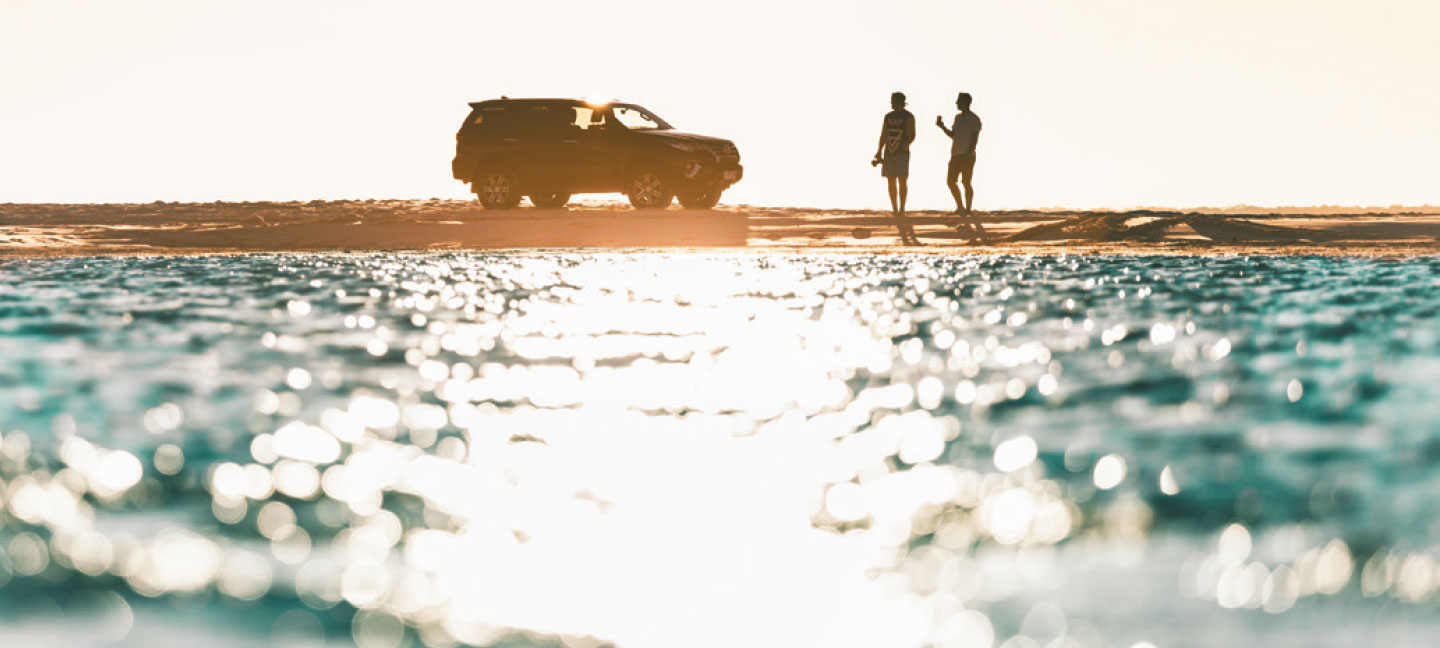Top tips for the ultimate summer road trip
20 Dec 2021 | Lee Atkinson
Getting ready for a road-trip summer? After the couple of years we’ve had, we all deserve the freedom of hitting the highway and letting some distance wash our worries away. Whether you’ve planned, or are planning a road trip, we think the tips below extracted for Ultimate Road Trips: Australia by Lee Atkinson are going to be handy to ensure the smoothest possible holiday.
Top Road Trips Tips from Lee Atkinson
Australians and tourists alike have always loved a good road trip. Whether it’s a leisurely Sunday drive through the wineries or to the beaches near our capital cities, a quick weekend getaway to the mountains, a summer family holiday travelling our beautiful coastline or roughing it on a remote outback track, hitting the road is our favourite way to spend our holiday time. So to help you get the most out of your time on the road, we’ve put together a collection of 40 of the best driving holiday routes in Australia.
In this guide you’ll find everything you need to know to plan your next driving holiday. To help make the planning easier we’ve organised Ultimate Road Trips Australia into eight themed sections: bucket-list drives, long weekends and short breaks, gourmet getaways, coastal road trips, capital city to capital city trips, country drives, outback adventures and epic journeys. Each of the 40 road trip chapters includes things to see and do, route maps and a handy list of distances to help you plan your trip, as well as useful advice on family-friendly attractions, where to eat and the best hotels, guesthouses, caravan parks and camping spots. You’ll also find details on weather conditions and where to find more information.
Keep this book in the car for when you’re out on the road, or curl up with it at home and dream about your next journey. Bon voyage, and have a safe trip!
 Helpful Information
Helpful Information
DRIVING ON UNSEALED ROADS
Many of the roads in country areas are unsealed; they can be bumpy and dusty, but unless otherwise signposted are generally fine for conventional 2WD vehicles when conditions have been dry. After heavy rains, however, they may take days to dry out. Travelling on roads that have a ‘closed road’ sign, even if you are in a 4WD vehicle, may incur a substantial fine.
TOWING A CARAVAN
Unless otherwise noted in the text, most of the roads covered in this guide are suitable for caravans, but road conditions can and do change, so always check local conditions before setting out, particularly if it has been raining recently.
Be aware of your van’s height and weight – you’ll often come across low-level bridges in country areas. Before you leave home, measure the height of your van or motorhome, including any rooftop airconditioners and so on, and put it on a sticker on your windscreen or dashboard to remind you. Do the same with your total laden weight, as some bridges have a 3 tonne limit – as do some country roads after rain.
DRIVING IN SNOW
Snow chains must be carried on certain roads between 1 June and 10 October in alpine areas of New South Wales and Victoria. Unless you intend to do a lot of driving in snow- and ice-affected regions, the best option is to hire chains, which are widely available in these areas in winter. Make sure you ask for a demonstration of how to correctly fit your chains before you leave.
DRIVING IN THE OUTBACK
Outback driving can be challenging and potentially hazardous, but the following tips should help you plan and stay safe.
- The most important thing to remember when driving on remote tracks in the outback is to ensure you are carrying enough water, basic spare parts, food and fuel. Remember fuel and supply outlets in remote areas are not often open after hours or on weekends.
- If you do get into trouble, never ever leave your vehicle. Most people who have perished in the outback died while trying to walk to help. Wait until help comes to you.
- Station properties are often unfenced in the outback, so watch for cattle and wildlife on roads and avoid driving at night. Always leave gates as you found them.
- When driving over sandhills or through drifts of sand, lower your tyre pressure to approximately 15 psi to help avoid getting bogged (but don’t go below 10 psi, as it’s very easy to roll the tyre off the rim when making turns or stake the tyre on sharp wood hidden in the sand).
- Bulldust is a superfine sand a bit like red talcum powder and it’s everywhere in the outback. It’s slippery and hard to see, so you’ll often hit a patch when you least expect it. Aside from handling difficulties, it can make following, overtaking or passing oncoming vehicles very difficult as your windscreen will be swamped by dust. Shift down a gear quickly if you hit a patch and steer carefully. Watch for the end of the dust patch because a sudden hard edge can deflate your tyres or even bend rims.
- Do not enter dips at high speed. Brake on entry and accelerate again as you exit to gain maximum clearance.
- Check tracks across creeks for clear passage andwater depth.
- Do not camp in dry creek beds. Flash floods can occur without warning.
- Give road trains a wide berth. Slow down and, if there is an escort vehicle, watch for signals. If you move off the road, reduce speed and watch for guide posts and soft edges.
Get Road Ready
Before you leave home, give your car the ten-step once-over.
- Service please – get your vehicle serviced by a licensed mechanic before you leave home.
- The good oil – engines like fresh oil, so treat your engine to a lube. And check it regularly while on your trip to make sure it doesn’t get low.
- Keep your cool – check your radiator coolant level and top it up if necessary. If you’re heading a long way from help, carry some spare hoses and a bottle of coolant with you.
- Power rangers – you’d be amazed how many people get stranded with a flat battery, especially if they are running portable fridges, chargers or night lights. Carry a spare and turn off appliances overnight.
- Keep the pressure on – most of us forget to check tyre pressure. Carry, and use, a tyre gauge. Before you leave, check the tread and make sure you have a spare in good condition.
- The right tools – a basic tool kit should include a jack, jacking plate and wheel-replacement tools, spare tyre, fire extinguisher, emergency fuel supplies if heading off the beaten track, engine oil, coolant, jumper leads, spare radiator hoses and fan belts and the tools you’ll need to replace them.
- First aid – never travel without a first-aid kit, and always carry extra drinking water.
- Pack it in – don’t overload your car or carry unrestrained items in the backseat (even a flying book can cause serious injury in a crash). If it won’t fit in the boot, either don’t take it or make sure it is well secured. If you’re travelling in a wagon or 4WD, install a cargo barrier.
- Take the right maps or a good sat nav – fighting over which is the right way to go is a major cause of holiday (and relationship) breakdowns.
- Play it safe – make sure your vehicle and home insurance policies are up to date. Cancel any home deliveries, get the neighbours to collect your mail and install a timer switch on a light or two. Join your state auto club, such as the RAA or NRMA, to help you out in the event of a breakdown.
Family Road Trip Survival Guide
Road tripping with kids can be fun. Here are six tips on how to make sure everyone enjoys the drive.
- Plan ahead – the secret to successful road tripping with kids is not to be too ambitious in terms of how far you think you can get in one session. Allow twice as long for the journey as you normally would, allocating plenty of time for rest breaks (plan them in advance). Take the time to get off the highway and stop at a park or swimming pool rather than a roadhouse. It goes without saying that wherever you choose to stop should have toilets, but try to choose places with playgrounds or at least an expanse of grass where the kids can run around and burn off some energy. Bring games (inflatable balls are a good space saver) to play with on these breaks.
- Map it out – get the kids involved in planning your trip. Make a map of your trip before you leave home, letting them pick a couple of things they’d like to see and do along the way. Decorating the map with drawings or stickers of what they see (or keeping a journal/scrapbook) as you travel is a great way to keep them occupied. Collect postcards at each town you drive through – buy a book of stamps before you leave home and the kids can post them off on the spot. Another option is to create a treasure list of things to find at each stop. If the kids are old enough, let them navigate – then they can answer your ‘are we there yet?’ questions.
- Staying healthy – make sure you have enough medication if your kids get car sick (dose them up before you hit the road, not once they feel unwell). Carry a plastic bucket (with a lid) and plenty of wet wipes just in case. Roadhouse food is usually atrocious, unhealthy and expensive. Pack a bag of healthy snacks, sandwiches and drinks – but go easy on the sugar and anything that can spill or stain.
- Keeping kids amused – pack some toys and games but don’t even think about asking them to share: let each child have their own bag of things to play with. Avoid books if your kids are prone to motion sickness and avoid anything hard, sharp or tricky to clean if spilt (or doodled) on upholstery. Have a storytelling competition or make it a team effort, where each person adds a line. Read them a book, listen to an audio book or podcast some children’s stories. Don’t underestimate the power of old-fashioned games like I-spy, spelling bees, word games, ‘who am I?’ and so on – the internet is full of quirky suggestions, just google ‘road trip games’. If all else fails, tablets and portable DVD players are a lot cheaper than they used to be and most run via the 12-volt outlet in the car – don’t forget headphones.
- Pack a survival bag – put everything you might need, like a change of clothes, towel, swimmers, jumpers, torch, medication and, even pyjamas, in a bag to carry in the car to save repacking the boot every time you need something.
- Avoid driving at night – in theory the idea that driving through the night will mean the kids sleep while you motor in peace is a tempting proposition, but in reality you’ll just end up dog-tired the next day while they are full of beans. Driving in the dark on country roads also means that the chance of colliding with wildlife is high.

Ultimate Road Tripsby Lee Atkinson
Available now at your local bookstore and online




